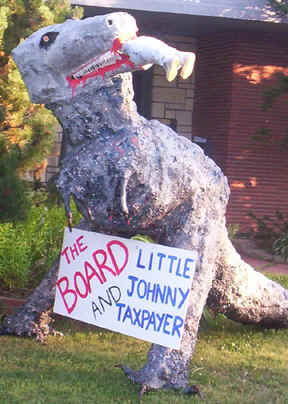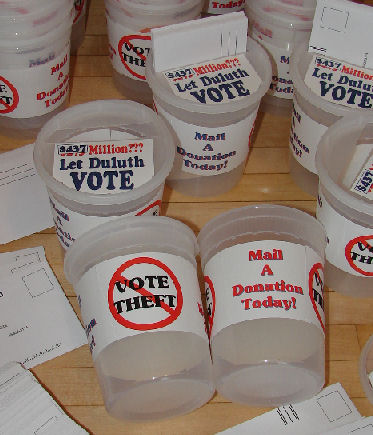


Do you know some place where we could put our return envelopes
for supporters to mail back donations?
Tell us where and we'll deliver them.
Donations online are no longer being processed.
|
|
Is the Red Plan going to boost Duluth's economy? Yes and No Are the right people paying the price? NO! On Monday, June 1st, 2009 the Duluth Chamber of Commerce (after a year of embarrassed silence on the Red Plan) has been prodded to re-embrace it. They paid for a study which discovered the multiplier effect. If you spend a buck it becomes a buck fifty as other people spend the money you've spent. Surprise, surprise, that's what the sophisticated economic software discovered will happen when Duluth spends $293 million on the Red Plan. But as the study's author quickly agreed. This tells us nothing else. Will our schools be better? Are the right people footing the bill. Could the multiplier effect be reversed by negative consequences of the much panned Red Plan. Let Duluth Vote prepared a brief analysis of its own suggesting that the Red Plan may cause long term harm to the economy. The Chamber did not want it to be passed out but a few people picked up copies as they left the meeting. There were a lot of architects, contractors and JCI suits at this luncheon. This is the Let Duluth Vote
Analysis: Let
PREFACE Supporters and opponents of the Red Plan both want Duluth’s Public Schools to be the best in Clearly some people will benefit from spending $300 million at least in the short term Let Duluth Vote would like the BBER to address these following questions. THE INDIRECT ECONOMIC DAMAGE OF A FLAWED If the completion of the Red Plan results in a damaged school system with lost programs, students and the revenue that follows them and new maintenance expenses for schools that are suffering from unanticipated out-migration how will the damage to the reputation of the Duluth schools affect local business and efforts to attract new business to Duluth and the local economy? Would a short term economic benefit outweigh long term economic problems? WEALTH TRANSFER Because the Red Plan will transfer wealth away from residents who live on fixed incomes several questions are in order. Unlike the Federal Stimulus Plan which is based on
progressive income taxes and on the Federal Government’s ability to mint money
the Red Plan will be paid for by regressive property taxes. Even now many The precipitous growth in property taxes, the 56% increase
in Considering this, what economic benefits can property tax payers expect from the Red Plan and the additional tax increases its completion will require? DEMOGRAPHIC UNCERTAINTY Does Chamber of Commerce’s BBER study take into account
the negative impacts on different Has the BBER study analyzed the costs will be imposed on COSTS ASSOCIATED WITH RAMPANT OUT MIGRATION OF STUDENTS It has become apparent that a major out migration of This will also have the ironic result of leaving Has the BBER study investigated this out-migration and would it predict that the new school buildings will have countervailing benefits? OTHER COSTS Does the BBER study take this into account? LOCAL REVENUE TRANSFERRED OUT OF STATE *In a letter to the District the current project manager
Johnson Controls indicated that the usual costs for construction management were
in the neighborhood of 12.8% but that they estimated their charges would be18.8%
or six percent greater. Would it not be prudent for ENERGY COSTS No transportation study was completed before the construction of the Red Plan. However the School Administration estimated that annual increased fuel costs for bussing more students longer distances to school could match or exceed $400,000 dollars. As fuel prices face further increases so to will this annual drain of the school operations budget. Similarly Johnson Controls and the School Administration
have denied the existence of any data having to do with the existing air quality
of our schools. Yet almost a third of the Red Plan’s costs are being spent to
address air quality. Much of this cost comes in the form of energy intensive air
conditioning the use of which will drive up energy costs to operate Did the BBER analyze the affect of increased energy usage in the Duluth Schools? ENVIRONMENT There is currently a significant uproar over the
environmental consequences of placing a high school on the Ordean site. The new
plans for Ordean have set it on a smaller site than originally planned and added
new structures which will tax the neighborhood. Impervious surfaces have been
greatly expanded and will compromise runoff into Among the extraordinary costs at Ordean to compensate for its substandard size are a 25 foot excavation, 115,000 cubic yards of fill (the equivalent of 11,500 trucks), nearly a thousand feet of retaining walls, underground water retaining chambers and the purchase of off-site properties to build parking spaces which will still be insufficient and lead to unsafe crossing at busy through streets Has the BBER analyzed long term environmental costs of the Red Plan? CONFLICT OF INTEREST Mr. Digby who has helped prepare the BBER Red Plan economic study also was recently appointed to the Duluth Planning Commission. That commission will meet on June 18th to vote on whether to require an Environmental Impact Study on the Ordean site. Will Mr. Digby recuse himself from that vote? OUT MIGRATION OF Roughly 70% of the The following figures show the financial situation the Fiscal Year end………..ISD 709 reserves In
This year’s open enrollment figures for
This year But the loss to the Duluth Schools does not end here. Calls to three surrounding school districts shows that an additional 80 students will be added to the Hermantown, Proctor and Wrenshall school’s next year. Hermantown also has a waiting list. While any student leaving the This graphic from the Duluth News Tribune shows
There have been other losses to the The It is conceivable that by next year close to 10 % of
|
|